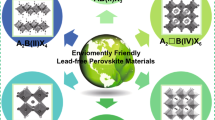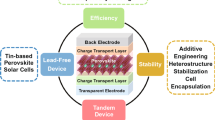Abstract
A non-platinum metal catalyst, TiNx-C, was synthesized through the high-pressure pyrolysis method, which was characterized using a transmission electron microscope, surface area measurement, X-ray photoelectron spectroscopy (XPS), and X-ray absorption fine structure (XAFS) studies. XPS analysis indicates the presence of Ti in 4 + oxidation state, and XAFS measurement indicates the coordination number of Ti to be 4 and the Ti-N bond length to be 2.1 Å. Ti-C was used as reference material. After fabricating dye-sensitized solar cell (DSSC), TiNx-C catalyst-based counter electrode (CE) exhibited comparable electrical performance as Pt-based counter electrode. Replacing Pt with inexpensive TiNx-C is considered an effort to lower the cost of the DSSC. In the DSSC, the TiNx-C CE showed comparable performance to Pt CE. Using TiNx-C as CE, a FF of 0.58, η of 6% JSC of 14.4 mA cm−2, and VOC of 0.73 V were obtained. The Pt CE-based DSSC exhibited a FF of 0.58, η of 7.2%, JSC of 16.0 mA cm−2, and VOC of 0.78 V.
Graphical abstract








Similar content being viewed by others
Change history
28 January 2023
A Correction to this paper has been published: https://doi.org/10.1007/s10008-023-05412-1
References
Lee Y-L et al (2010) A platinum counter electrode with high electrochemical activity and high transparency for dye-sensitized solar cells. Electrochem Commun 12(11):1662–1665
Chen L et al (2010) Fabrication of high performance Pt counter electrodes on conductive plastic substrate for flexible dye-sensitized solar cells. Electrochim Acta 55(11):3721–3726
Imoto K et al (2003) High-performance carbon counter electrode for dye-sensitized solar cells. Sol Energy Mater Sol Cells 79(4):459–469
Murakami TN et al (2006) Highly efficient dye-sensitized solar cells based on carbon black counter electrodes. J Electrochem Soc 153(12):A2255–A2261
Lee WJ et al (2009) Efficient dye-sensitized solar cells with catalytic multiwall carbon nanotube counter electrodes. ACS Appl Mater Interf 1(6):1145–1149
Wu M et al (2011) Low-cost dye-sensitized solar cell based on nine kinds of carbon counter electrodes. Energy Environ Sci 4(6):2308–2315
Kavan L, Yum JH, Grätzel M (2010) Optically transparent cathode for dye-sensitized solar cells based on graphene nanoplatelets. ACS Nano 5(1):165–172
Saito Y et al (2004) I−/I3− redox reaction behavior on poly(3,4-ethylenedioxythiophene) counter electrode in dye-sensitized solar cells. J Photochem Photobiol A 164(1–3):153–157
Lee K-M et al (2009) A high-performance counter electrode based on poly(3,4-alkylenedioxythiophene) for dye-sensitized solar cells. J Power Sources 188(1):313–318
Yan X, Zhang L (2013) Polyethylene glycol-modified poly(3,4-ethylene dioxythiophene):poly(styrene sulfonate) counter electrodes for dye-sensitized solar cell. J Appl Electrochem 43(6):605–610
Wang S et al (2013) Study of H2SO4 concentration on properties of H2SO4 doped polyaniline counter electrodes for dye-sensitized solar cells. J Power Sources 242:438–446
Tai Q et al (2011) In situ prepared transparent polyaniline electrode and its application in bifacial dye-sensitized solar cells. ACS Nano 5(5):3795–3799
Levy R, Boudart M (1973) Platinum-like behavior of tungsten carbide in surface catalysis. Science 181(4099):547–549
Oyama S (1992) Preparation and catalytic properties of transition metal carbides and nitrides. Catal Today 15(2):179–200
Jang JS et al (2010) Platinum-free tungsten carbides as an efficient counter electrode for dye sensitized solar cells. Chem Commun 46(45):8600–8602
Wu M et al (2011) Low-cost molybdenum carbide and tungsten carbide counter electrodes for dye-sensitized solar cells. Angew Chem Int Ed 50(15):3520–3524
Wu M et al (2012) Economical Pt-free catalysts for counter electrodes of dye-sensitized solar cells. J Am Chem Soc 134(7):3419–3428
Wu M et al (2011) Two flexible counter electrodes based on molybdenum and tungsten nitrides for dye-sensitized solar cells. J Mater Chem 21(29):10761–10766
Jiang Q et al (2010) Surface-nitrided nickel with bifunctional structure as low-cost counter electrode for dye-sensitized solar cells. J Phys Chem C 114(31):13397–13401
Li G et al (2011) Highly Pt-like electrocatalytic activity of transition metal nitrides for dye-sensitized solar cells. Energy Environ Sci 4(5):1680–1683
Wu M, Ma T (2012) Platinum-free catalysts as counter electrodes in dye-sensitized solar cells. Chemsuschem 5(8):1343–1357
Guo J et al (2013) Highly efficient telluride electrocatalysts for use as Pt-free counter electrodes in dye-sensitized solar cells. Chem Commun 49(86):10157–10159
Wu M et al (2012) High-performance phosphide/carbon counter electrode for both iodide and organic redox couples in dye-sensitized solar cells. J Mater Chem 22(22):11121–11127
Dou Y et al (2012) Nickel phosphide-embedded graphene as counter electrode for dye-sensitized solar cells. Phys Chem Chem Phys 14(4):1339–1342
Xin X et al (2011) Low-cost copper zinc tin sulfide counter electrodes for high-efficiency dye-sensitized solar cells. Angew Chem Int Ed 50(49):11739–11742
Wang J, Xin X, Lin Z (2011) Cu2ZnSnS4 nanocrystals and graphene quantum dots for photovoltaics. Nanoscale 3(8):3040–3048
Zheng X et al (2013) Low-cost and high-performance CoMoS4 and NiMoS4 counter electrodes for dye-sensitized solar cells. Chem Commun 49(83):9645–9647
Yuan SJ et al (2013) Enhanced performance of dye‐sensitized solar cells using solution‐based in situ synthesis and fabrication of Cu2ZnSnSe4 nanocrystal counter electrode. Chem A Eur J 19(31):10107–10110
Yang J et al (2013) In situ grown vertically oriented CuInS2 nanosheets and their high catalytic activity as counter electrodes in dye-sensitized solar cells. Chem Commun 49(20):2028–2030
Lin J-Y, Chou S-W (2013) Highly transparent NiCo2S4 thin film as an effective catalyst toward triiodide reduction in dye-sensitized solar cells. Electrochem Commun 37:11–14
Kushwaha S et al (2017) A non-platinum counter electrode, MnNx/C, for dye-sensitized solar cell applications. Appl Surf Sci 418:179–185
Kothandaraman R et al (2009) Non-precious oxygen reduction catalysts prepared by high-pressure pyrolysis for low-temperature fuel cells. Appl Catal B 92(1):209–216
Nallathambi V et al (2011) Nitrogen precursor effects in iron-nitrogen-carbon oxygen reduction catalysts. Electrochem Solid-State Lett 14(6):B55–B58
Karthikayini M et al (2016) Highly active and durable non-precious metal catalyst for the oxygen reduction reaction in acidic medium. J Electrochem Soc 163(6):F539–F547
Palanivelu K et al (2015) Controlling the nitrogen content of metal-nitrogen-carbon based non-precious-metal electrocatalysts via selenium addition. J Electrochem Soc 162(6):F475–F482
Jaouen F et al (2011) Recent advances in non-precious metal catalysis for oxygen-reduction reaction in polymer electrolyte fuel cells. Energy Environ Sci 4(1):114–130
Waychunas G et al (1993) Surface chemistry of ferrihydrite: Part 1. EXAFS studies of the geometry of coprecipitated and adsorbed arsenate. Geochimica et Cosmochimica Acta 57(10):2251–2269
Grunes L (1983) Study of the K edges of 3d transition metals in pure and oxide form by x-ray-absorption spectroscopy. Phys Rev B 27(4):2111
Bair RA, Goddard WA III (1980) Ab initio studies of the X-ray absorption edge in copper complexes. I. Atomic Cu2+ and Cu(II)Cl2. Phys Rev B 22(6):2767
Farges F, Brown GE, Rehr J (1997) Ti K-edge XANES studies of Ti coordination and disorder in oxide compounds: Comparison between theory and experiment. Phys Rev B 56(4):1809
Magnuson M et al (2007) Bonding mechanism in the nitrides Ti2AlN and TiN: An experimental and theoretical investigation. Phys Rev B 76(19):195127
Unny D et al (2018) Effect of flexible, rigid planar and non-planar donors on the performance of dye-sensitized solar cells. J Electrochem Soc 165(13):H845–H860
Kushwaha S et al (2016) A DSSC with an efficiency of ∼10%: fermi level manipulation impacting the electron transport at the photoelectrode-electrolyte interface. ChemSelect 1(19):6179–6187
Acknowledgements
Financial support in the form of a seed grant from IOE, BHU, Varanasi to Suman Kushwaha is gratefully acknowledged.
Author information
Authors and Affiliations
Corresponding authors
Additional information
Publisher's Note
Springer Nature remains neutral with regard to jurisdictional claims in published maps and institutional affiliations.
Rights and permissions
Springer Nature or its licensor (e.g. a society or other partner) holds exclusive rights to this article under a publishing agreement with the author(s) or other rightsholder(s); author self-archiving of the accepted manuscript version of this article is solely governed by the terms of such publishing agreement and applicable law.
About this article
Cite this article
Kushwaha, S., Mandal, S. Non-precious transition metal-based counter electrodes for dye-sensitized solar cells. J Solid State Electrochem 27, 103–110 (2023). https://doi.org/10.1007/s10008-022-05301-z
Received:
Revised:
Accepted:
Published:
Issue Date:
DOI: https://doi.org/10.1007/s10008-022-05301-z




